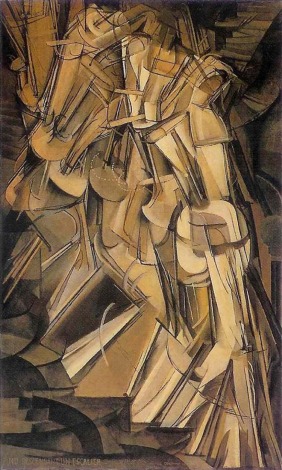Duchamp’s “Nude Descending a Staircase, No. 2” was dubbed one of the most famous and controversial paintings of its day . Along with the cubist school of which it was a part, it helped to change the way artists and the public perceived art, and its influence persists down to the present day . Less known but no less notable is the fact that “Nude Descending” also offers important educational insights to radiologists, particularly regarding the daily work of radiologic interpretation.
The Nude
Born in Normandy, France, in 1887, Marcel Duchamp grew up in a household filled with paintings by his grandfather, Emile Nicolle . Three of his brothers also became successful artists. As a student, Duchamp excelled in mathematics and art, and after graduation he sold cartoons that combined verbal and visual puns. After service in the military, he began exhibiting his paintings and participating in regular discussions with cubist painters. In 1912, he painted “Nude Descending.”
Duchamp intended to exhibit “Nude Descending” at an art show in Paris, but it was rejected by his cubist peers. The hanging committee deemed it “ridiculous” to paint a nude descending a staircase, claiming instead that a nude should be “respected” by a more dignified pose. However, it was exhibited later in 1912 in Barcelona and the next year in New York, where it provoked harsh criticism. Teddy Roosevelt claimed that it might just as well be called, “A Well-Dressed Man Going Up a Ladder.”
The painting, which measures approximately 57 × 35 inches and features mainly ochre and brown hues, depicts a figure composed of geometrical shapes that seems to be moving in a time-lapse fashion down some stairs ( Fig 1 ). The figure appears in sufficiently abstract form that its gender and age are impossible to determine. At the bottom of the painting appears, in block letters, a phrase in French, “NU DESCENDANT UN ESCALIER.”
Cubism
“Nude Descending” both inhabits and transcends the cubist vision. The Cubists, including founders Georges Braque and Pablo Picasso, abandoned the Renaissance’s emphasis on perspective, which sought to capture the three-dimensionality of a figure or scene as viewed from a particular point of view . They also moved away from the realistic depiction of figures, instead creating images the likes of which the human eye had never beheld in the real world.
Get Radiology Tree app to read full this article<
Get Radiology Tree app to read full this article<
Radiologic Perspectives
Get Radiology Tree app to read full this article<
Get Radiology Tree app to read full this article<
Get Radiology Tree app to read full this article<
Get Radiology Tree app to read full this article<
Get Radiology Tree app to read full this article<
Get Radiology Tree app to read full this article<
Get Radiology Tree app to read full this article<
Get Radiology Tree app to read full this article<
Get Radiology Tree app to read full this article<
Get Radiology Tree app to read full this article<
Get Radiology Tree app to read full this article<
Get Radiology Tree app to read full this article<
You mentioned earlier that you are engaged to be married. Do you have a photograph of your fiancée? May I see it? [Viewing the photograph, he expresses great surprise, perhaps even horror.] She’s kind of small, isn’t she?
Get Radiology Tree app to read full this article<
Get Radiology Tree app to read full this article<
References
1. Duchamp M. Nude descending a staircase, No. 2. 1912. Oil on canvas. Philadelphia Museum of Art.
2. Kushner M.S., Orcutt K.: The armory show at 100: modernism and revolution.2013.D. GilesLondon
3. Tomkins C.: Duchamp: a biography.1998.HoltNew York
4. Golding J.: Cubism: a history and analysis.1968.Boston Book and Art ShopBoston
5. Krupinski E., Chung A., Applegate K., et. al.: Impact of patient photographs on radiologists’ visual search of chest radiographs. Acad Radiol 2016; 23: pp. 953-960.
6. Solso R.: Cognition and the visual arts.1996.MIT PressCambridge, MApp. 236.
